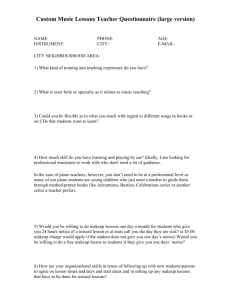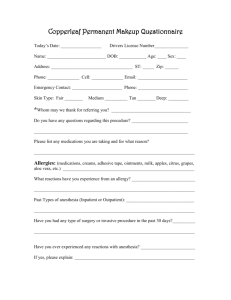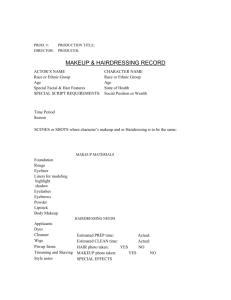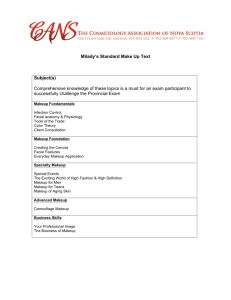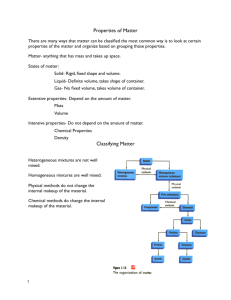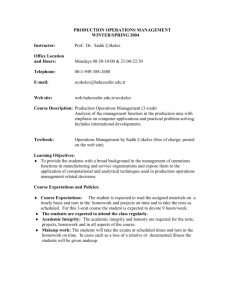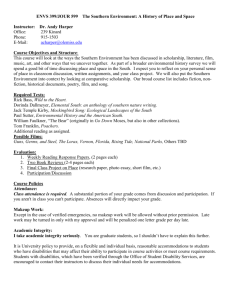Ch 24
advertisement
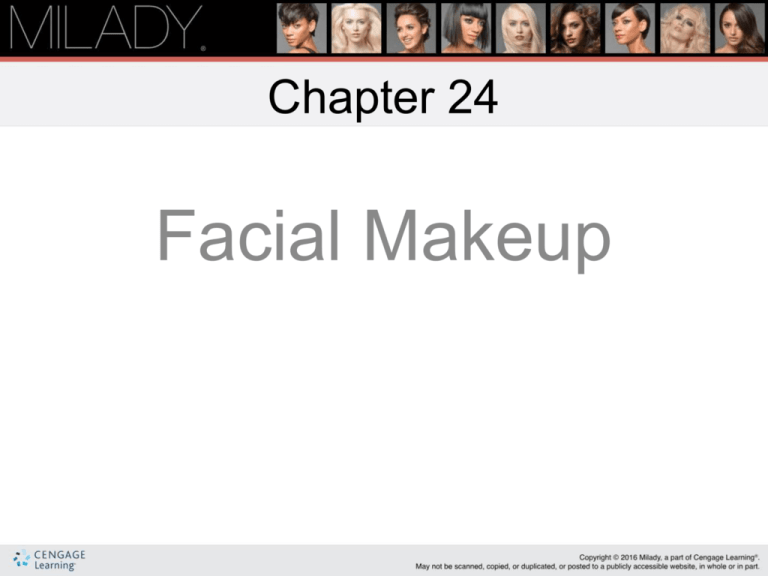
Chapter 24 Facial Makeup Learning Objectives • Describe the various types of cosmetics and their uses for facial makeup. • Explain how to use color theory when choosing cosmetics for makeup application. • Identify different facial types and summarize basic makeup techniques to alter them. • Name and describe the two types of artificial eyelashes. • List tips for creating special-occasion makeup for eyes, cheeks, and lips. Introduction • The field of makeup artistry is a very rewarding segment of cosmetology. • The makeup application techniques you employ will vary as greatly as the skin types and personalities of your clients. • The goal of effective makeup application is to enhance the client's individuality, rather than offering a ‘makeover’ based on some ideal standard. Describe Facial Makeup and Their Uses • Foundation – tinted cosmetic also known as base makeup that is used to cover or even out skin coloring; conceal minor imperfections of skin; and protect the skin from climate, dirt, and debris. • Available in liquid, stick, and cream forms. • Primer – used to help disguise less than perfect skin Foundation Chemistry • Liquid – water-based foundations with emollients • Oil-free – intended for oilier skin types • Cream – oil-based and thicker than liquid Concealers • Hides dark eye circles • Covers blemishes and discolorations • Available in tins, jars, or tubes with wands Face Powders • Adds matte finish, absorbs oil, and sets foundation • Comes loose or pressed • Mixture of talc or cornstarch and pigment Eye Shadow © Kubais/Shutterstock.com • Accentuates eye shape • Compliments eye color Eyeliner © Africa Studio/Shutterstock.com • Used to define the eyes • Makes the lash line appear fuller Eyebrow Color • Used to add color and contour brows • Available in pencil and powder form • Should not harshly contrast with haircolor Cheek Color • Called blush or rouge • Comes in powder, gel, or cream • Application should look soft and natural Lip Color • Lipstick or gloss – Formulas of oils, waxes, and dyes – Used to enhance or correct the shape of the lips • Lip liner – Used to outline lips; keeps lip color from feathering Mascara • Used to darken and thicken lashes • Some contain lengthening fibers © kedrov/Shutterstock.com • Polymer product: Includes water, wax, thickeners, film formers, and preservatives Other Cosmetics • Eye makeup removers • Greasepaint • Cake (pancake) makeup Makeup Brushes and Other Tools • Hair – the term for the bristles • Ferrule – the metal part that holds the brush intact and supports the strength of the bristles. • Handle – comes in a wide range of lengths and can be made of wood, acrylic, plastic, or metal. • Gently cleanse brushes with an antibacterial detergent followed by a commercial cleaning solution. (continues) Makeup Brushes and Other Tools (continued) • • • • • • • • Powder brush Blush brush Concealer brush Lip brush Eye shadow brush Eyeliner brush Angle brush Lash comb • • • • Brow brush Tweezers Eyelash curler Pencil sharpener Single-Use Implements • Sponges • Powder puffs • Mascara wands • Spatulas • Disposable lip brushes • Sponge-tipped shadow applicators • Cotton swabs • Cotton pads or puffs How to Use Color Theory for Makeup Application Warm and Cool Colors • Warm and cool colors form the basis of all makeup application. • Three main factors to consider when choosing colors for a client: skin color, eye color, and hair color. Determining Skin Color Selecting Makeup Colors • Fair skin color • Medium skin color • Deep skin color Complementary Colors for Eyes • Neutrals are safest • Blue eyes – Orange, gold, peach, copper, mauve, plum, taupe, camel • Green eyes – Brown-based reds, red-orange, red-violet, violet, coppers, rusts, pinks, plums, mauve, purples • Brown eyes – Can wear any color: Greens, blues, grays, silvers Adding Cheek and Lip Color • Cheek and lip color – Coordinate in same color family as eye makeup • Hair and eye color – Coordination of hair and eye color with eye makeup Hair Color and Eye Color • Older clients that may have uneven, textured skin due to wrinkles or sun damage. • Shimmer, glitter, or frosted colors can accent dry patches or wrinkles. © Kurhan/Shutterstock.com Mature Skin Alter Face Shapes with Makeup • Highlight • Contour Analyzing Face Shape: Oval Analyzing Face Shape: Round Analyzing Face Shape: Square Analyzing Face Shape: Triangular Analyzing Face Shape: Heart-Shaped Analyzing Face Shape: Diamond Analyzing Face Shape: Oblong Altering the Forehead Area • Low forehead • Protruding forehead Altering the Nose and Chin Areas • Large or protruding nose • Short and flat nose • Broad nose (continues) Altering the Nose and Chin Areas (continued) • Protruding chin and receding nose • Receding chin • Sagging double chin Altering the Jawline • Broad jawline • Narrow jawline © survald/Shutterstock.com Altering Eye Shape: Round Eyes Altering Eye Shape: Close-Set Eyes Altering Eye Shape: Protruding or Bulging Eyes • This can be minimized by blending the deeper color shadow over the prominent part of the upper lid. • Blend the color from the outer corners inward toward the center, carrying it just past the creases. Altering Eye Shape: Hooded Eyes Corrective Makeup for the Eyes Small eyes Wide-set eyes Deep-set eyes Altering Eyebrows Ideal shape (continues) Altering Eyebrows (continued) • • • • • • Low forehead Wide-set eyes Close-set eyes Round face Long face Square face Eyelash Enhancers • Lash enhancers and lengtheners contain fibers to make lashes look longer and fuller. • Latisse®, a product containing bimatoprost, shows a difference in two to four months of regular use. The Lips (continues) The Lips (continued) Skin Tones and Camoflaging Techniques • Skin tones – Ruddy skin (red) – Sallow skin (yellow) • Camouflaging techniques Steps for Basic Makeup Application • Step-by-step procedure to enhance your client's features. (continues) Steps for Basic Makeup Application (continued) Client Consultation • Consultation area • Lighting • Information gathering (continues) Steps for Basic Makeup Application (continued) Apply Foundation • Blend with disposable makeup sponge. • Avoid line of demarcation. © Pogonici/Shutterstock.com • Match to skin tone. (continues) Steps for Basic Makeup Application (continued) • Apply concealer • Apply eye shadow • Apply powder • Apply eyeliners • Apply eyebrow pencil • Apply blush • Apply eyebrow powder • Apply lip color • Apply mascara Apply Artificial Eyelashes © iStockphoto.com\Shariff Che\'Lah • Strip lashes • Remove strip eyelashes • Individual lashes Special-Occasion Makeup for Eyes © Kett Cosmetics. Makeup and photography by Sheila McKenna. Option 1: Striking contour eyes (continues) Special-Occasion Makeup for Eyes (continued) Option 2: Dramatic smoky eyes Special-Occasion Makeup for Cheeks • Use a darker blush color under the cheekbones to add definition. • Apply with a blush brush and blend carefully. • Add a brighter, lighter cheek color to the apples of the cheeks and blend. • Use a cheek color with shimmer or glitter over the cheekbones for highlights. You may use cream or powder colors. Special-Occasion Makeup for Lips • Line lips, fill with lip pencil, and blot. • Add lip color. • Apply gloss to center of lips. Summary and Review • How to identify the basic face shapes and that the oval shape has artistically ideal proportions and features. • Corrective makeup, shadowing, and highlighting, we can create the illusion of oval for almost any face shape. • We can contour the face through shadowing and highlighting, and minimize facial features that are unflattering. • How to use corrective makeup procedures. • Being able to effectively apply corrective makeup will make you as a professional very valuable to your clients. Chapter Review Questions 1. List eight types of facial cosmetics and how they are used. 2. List the two color temperatures and the range of shades they each encompass. 3. What is the purpose of special occasion makeup? Chapter Review Questions (continued) 4. What is the purpose of face shape altering makeup? 5. Name and describe the two types of artificial eyelashes. 6. List the key cosmetics used in the basic makeup procedure in the order in which they are applied.
